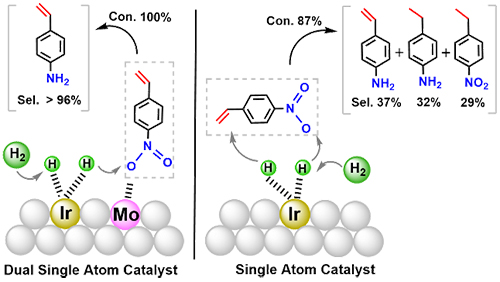Single-atom catalysts (SACs) are applied in heterogeneous catalysis. Instead of one type of single atom, dual single-atom catalysts (DSACs) deliver superior catalytic performance than SACs due to cooperation between the dual metal-atoms.
Understanding synergistic effects at the atomic scale is critical for the design of highly effective heterogeneous catalysts in chemical transformation.
Recently, Prof. HUANG Jiahui's group and Prof. FU Qiang's group from the Dalian Institute of Chemical Physics (DICP) of the Chinese Academy of Sciences (CAS), in cooperation with Prof. SI Rui from Shanghai Institute of Applied Physics, CAS, revealed synergistic catalysis of dual single-atom structure in the selective hydrogenation 4-nitrostyrene (4-NS) to 4-vinylaniline (4-VA).
The study was published in ACS Catalysis on January 29.

Synergistic effects for enhanced catalysis in a dual single-atom catalyst (Image by FU Junhong)
The researchers synthesized DSAC Ir1Mo1/TiO2 as well as SACs Ir1/TiO2 and Mo1/TiO2. They found that DSAC Ir1Mo1/TiO2 displayed a superior catalytic performance for selective hydrogenation of 4-NS to 4-VA than SACs Ir1/TiO2 and Mo1/TiO2.
Computational results indicated that H2 activation occurred on Ir1 and 4-NS adsorption via the nitro group preferentially occurred on Mo1, with the synergistic effect of Ir1 and Mo1 leading to enhanced catalytic performance.
This work elucidates the atomic level advantages of DSAC in promoting reaction mechanisms for efficient heterogeneous bimetallic catalysis.
This study was supported by National Natural Science Foundation of China, the Strategic Priority Research Program of Chinese Academy of Sciences, National Key R&D Program of China, Projects of International Cooperation and Exchanges NSFC, and International Postdoctoral Exchange Fellowship Program. (Text by FU Junhong)